Solutions for Electrical Contractors eTool
Prefabrication » Welding
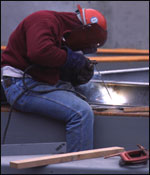
Welding in the controlled environment of a prefabrication shop rather than on-site makes it easier to control workplace risk factors. However, ergonomics-related issues such as size and positioning of work object, still remain.
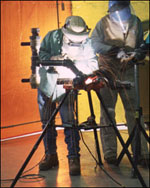
Potential Hazards
-
Employees frequently may assume awkward or static postures (Figure 1) for extended periods of time while welding.
-
Finishing a full weld may require a welder to bend or lean over the work piece, or reach overhead for several minutes. This may fatigue the low back and shoulders, especially since they support the welder's weight and the weight of the helmet, apron, and gloves.
-
Employees may spend extended periods of time standing or kneeling on hard cement floors. The prolonged standing may cause lower extremity discomfort, pain and fatigue as well as disorders of the back and low back pain. Kneeling causes contact stress and may result in injuries to the knees.
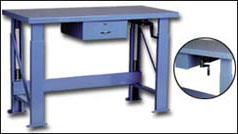
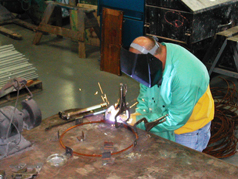
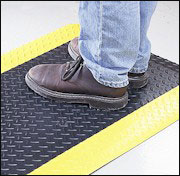
Possible Solutions
-
Provide height-adjustable tables (Figure 2) and jigs (Figure 3) that hold the piece in a position enabling employees to maintain neutral postures.
-
Provide anti-fatigue mats (Figure 4) and shoe inserts that may help reduce fatigue and discomfort caused by prolonged standing on hard floor surfaces. These mats help distribute the pressure from a hard floor evenly to the feet and may improve circulation.
-
Pre-plan welding jobs to minimize awkward postures.
-
Do not conduct welding on the ground or floor.
-
Avoid kneeling. Use low stools instead.
-
When kneeling is required, wear knee pads.
-
When purchasing new personal protective equipment, consider the weight of items such as helmets, aprons, and jackets to reduce the load that must be supported if employees must bend neck or trunk to perform tasks.
-
Provide a stand and hoist to get welding material to appropriate height to eliminate awkward postures.
-
Use adjustable rotator stands such as a retrofitted air or hydraulic lift package to better maintain a neutral posture while welding.

